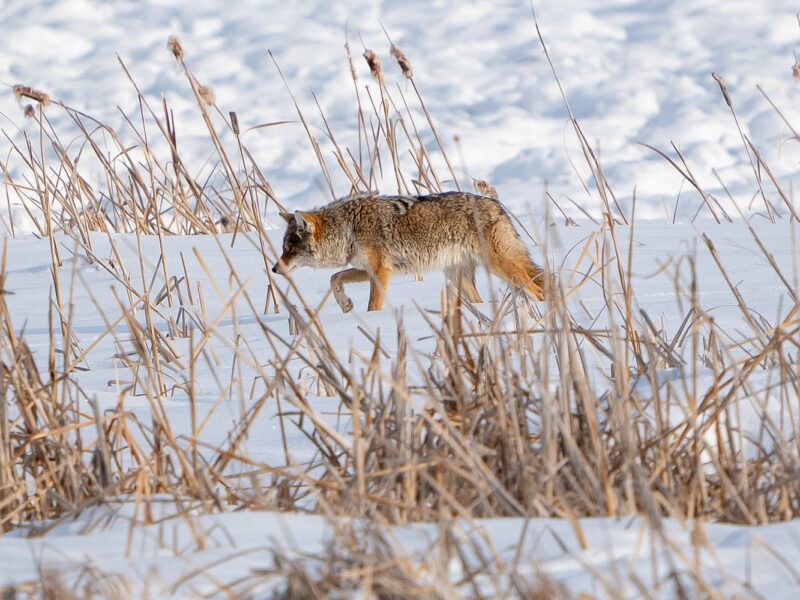Record Amount Is Being Devoted to Control ‘Nuisance Animals’
Wyoming beefs up efforts to eliminate coyote, ravens and other animals to protect livestock and wildlife
- Published In: Other News & Features
- Last Updated: Jun 03, 2023

Over the next year, Wyoming is devoting $4.2 million to control coyote and other predator populations that injure livestock. (Wyoming Truth photo by Sam Cook)
By K.L. McQuaid
Special to the Wyoming Truth
Beset by inflation and increases in the populations of predatory animals throughout Wyoming, state officials are boosting funding to combat so-called “nuisance animals,” such as coyotes and ravens, to a record level in the current biennial fiscal period.
The state’s 15-member Animal Damage Management Board (ADMB) voted last month to allocate $4.18 million to protect livestock and wildlife from growing wolf and other animal populations.
Historically, funding amounts to about $3.5 million annually. In May 2022, $2.737 million was allocated by the ADMB statewide, but Gov. Mark Gordon added another $737,500 to the board’s efforts the following month.
“It’s money well spent, because it really does help the producers of both sheep and cattle,” said Jim Magagna, who operates a sheep ranch north of Rock Springs and is the executive vice president of the Wyoming Stock Growers Association, a trade group.
“And the need has grown as the protection of various species has grown,” Magagna added. “Historically, predator control occurred through a combination of removing animals and with the use of poisons, but poisons have largely been taken away as a tool. So today we rely more on aerial hunting, but that’s expensive, and the amount of funding to the need has not been proportional.”
The 2023-2024 money also will be used to enhance rabies control measures in 19 Predator Management Districts (PMD) statewide.
In approving the increased funding through June 30, 2024, officials cited inflationary pressures that have caused airplane and helicopter fuel and other necessary material costs to spike.
At least some of the funding also is expected to go toward raising trappers’ salaries.
“The cost of predator control continues to rise and the (Predator Management) Districts have struggled to maintain an effective predator control program,” the ADMB wrote in an annual report submitted to the governor’s office late last year.
“The additional funds allocated will allow several districts to add additional part-time trappers allowing these districts to continue protecting livestock and wildlife and allow them to continue to work with municipalities to control skunks and continue the rabies testing in their districts,” the report continued.
“The additional funding will also help counties offset some of the fuel cost increases for vehicles and aerial hunting.”
Many county PMDs received significant increases in funding with the latest allocations. Washakie County’s PMD, for instance, saw its funding climb by 47%, to $248,500 for the 2023-2024 fiscal period. Lincoln County’s PMD funding rose by 26%, according to ADMB records.
Natrona County’s PMD received the most funding, at $288,500, while Weston County’s district was allocated the least amount of money, at $133,500.
Officials from the ADMB, Wyoming Department of Agriculture and U.S. Department of Agriculture’s Wildlife Services did not respond to requests for comment.
Protecting livestock, deer
Statewide, much of the funding is used to control and kill predators that either feed on or injure cow calves or sheep, or prey on mule or pronghorn deer or sage grouse. Protecting deer has become especially important to Wyoming Game & Fish officials this year in the wake of recent extremely harsh winter, which resulted in many deaths.
Ranchers each year report thousands of dollars in losses of livestock to coyote, ravens, wolves, foxes, skunks, raccoons and other animals.
“It’s not an issue where we’ll ever be able to say we’ve taken care of it,” Magagna said. “It’s an ongoing battle, and unfortunately, there’s no one answer to it, even as there are still significant losses in livestock reported every year.”
The raven population, for instance, is believed to have tripled in the West in recent decades. The birds also don’t frighten easily and are largely immune from decoys and other methods to scare them off.
They are also relentless hunters known to peck out the eyes or tongues of young cattle or sheep for food.
To mitigate the damage, over 1,000 ravens are killed annually in Wyoming through the use of a special bird poison. Environmental groups have pushed back on the use of the poison, however, citing studies regarding its effectiveness and impact on other animals and humans.
Perhaps the most threatening predator to livestock populations, however, is the coyote.
That’s why most ADMB funding is dedicated to eradicating the animals, which, like the raven, have been growing in numbers in recent years.
Aerial hunting efforts kill over 10,000 coyote and other predatory animals statewide each year, according to ADMB reports. In Washakie County alone in 2021 and 2022, more than 400 coyotes were killed, records indicate.
Additional funding is expected shortly, as well.
In response to the severity of the past winter, Wyoming Game & Fish is expected to contribute $200,000 this year to the ADMB to kill coyotes to protect deer.
Livestock producers also will chip in financially to ADMB, with about $1 million generated by sales of cattle and sheep.
The Wyoming Legislature created the ADMB in 1999 to mitigate “damage caused to livestock, wildlife and crops by predatory animals, predacious birds and depredating animals,” according to ADMB.
Although the ADMB is a statewide program, much of the implementation for animal controls is administered through the U.S. Department of Agriculture’s Wildlife Services division, which must apply each year to the U.S. Fish & Wildlife Service for permission to kill nuisance animals.
The federal agency, which directs the Migratory Bird Treaty Act – regulations that, ironically, protect ravens – is part of the U.S. Department of the Interior.













